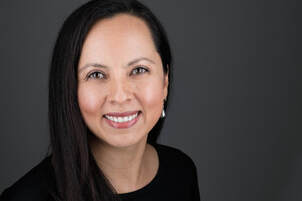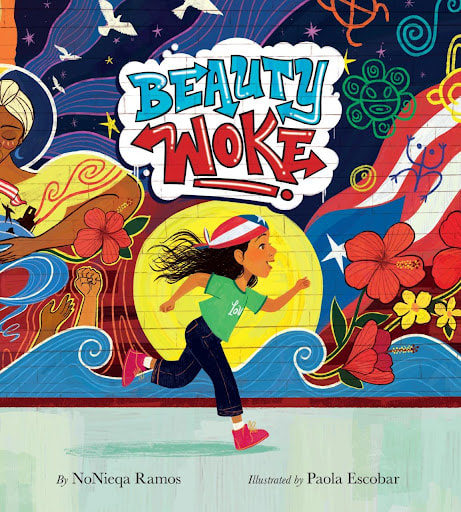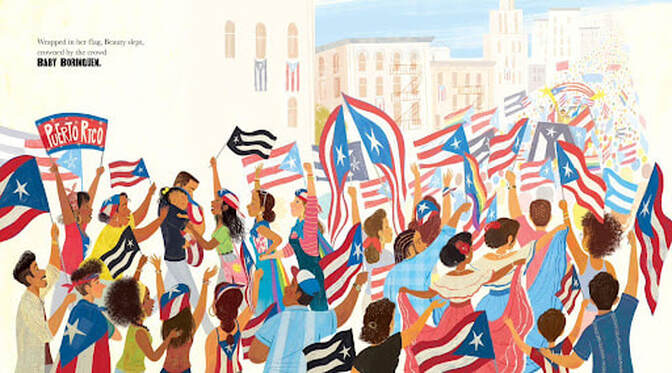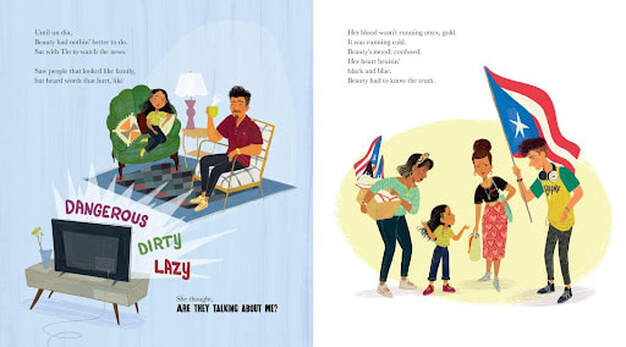|
Today on the blog, Musa Cynthia Harmony interviews NoNieqa Ramos about their newest picture book, Beauty Woke. But first, here's a little bit about the book: Beauty Woke is a powerful story of pride and community, told with bold lyricism and the heart of a fairy tale. Readers looking for a next-generation Sleeping Beauty will fall in love with the vivid art and lyrical text. For fans of Woke Baby and Dreamers. Beauty is a Puerto Rican girl loved and admired by her family and community. At first, she’s awake to their beauty, and her own—a proud girl of Taíno, and African descent. But as she grows older, and starts to lose sight of what makes her special because of phrases she overhears meant to make people who look like her feel smaller and scared, her community bands together to help remind her of her beautiful heritage. “Ramos’ poetic ode to identity and validation winds itself through evocative imagery in both English and Spanish, connecting the strength of community with self-acceptance. From one-word stanzas echoing with a mother’s heartbeat to flowing anthems of pride, each page exudes energy and passion. Escobar’s powerful panorama of diversity is a blazing exclamation point to Beauty’s triumphant journey. This bold manifesto of cultural awareness reaches out to awaken the sleepwalkers among us.” – Kirkus, starred reviews Cynthia Harmony: As a big fan of all your books, I’m thrilled to get a chance to chat with you about your newest picture book BEAUTY WOKE hitting book shelves on February 15th, 2022! Picture books are a long journey in the making, typically two years or more from acquisition to release, plus the time it takes to polish a first draft into a submission ready version. How was BEAUTY WOKE’s journey different from your two previous picture books? NoNieqa Ramos: Mil gracias, Cynthia! My family and I are eagerly awaiting the release of your debut MI CIUDAD SINGS, releasing June 14, 2022. Kwame Alexander’s imprint Versify sent out a Twitter invitation for writers to submit picture books, and I had my agent jump on the opportunity and send YOUR MAMA. It’s so important to find the right match with an editor and a publishing house. I’ll never forget receiving the call from Kwame with an offer for a two book deal during a staff team meeting at my middle school. I worked with Kwame and Erika Turner through the formative process of the YOUR MAMA before she left for other publishing prospects. Because of the fluidity–and volatility– of the publishing industry, I’ve learned it is typical to work with several editors! After YOUR MAMA’s acceptance, I had to decide what to submit next. I had the fortunate (and nerve-wracking!) surprise invitation to visit Kwame Alexander in his studio and read my draft for BEAUTY WOKE aloud. He read me a selection from a favorite childhood book and made brilliant suggestions-of course. The book was accepted shortly thereafter. During the editorial process, I worked with Kwame, Weslie–and Boricua Las Musas writers Mia Garcia and Carmen Rodriguez– to ensure factual, respectful, and dynamic Puerto Rican representation. Because BEAUTY WOKE deals with such sensitive topics as racism with a young audience, I labored feverishly to ensure I was treating my future readers with tender loving care. While YOUR MAMA was purely a work of joy and exultation, BEAUTY WOKE was a labor of pain and joy. Both are messages of unconditional love to children. CH: What an amazing journey and thank you for sharing the similarities and differences between YOUR MAMA and BEAUTY WOKE. Can you tell us about the inspiration for this story and any unexpected challenges or fortunate surprises along the way? NR: The inspiration for BEAUTY WOKE came from despair. In the original story of Sleeping Beauty, the parents love their daughter Aurora tremendously. But they don’t invite Maleficent to her christening, and she crashes the party to levy a curse. Aurora will prick her finger on a spinning needle and die on her sixteenth birthday. Her madrinas save her with a counter curse–that she will not die, but sleep, and that a prince can break the curse with a kiss.The King and Queen proceed to burn, destroy, and ban every spinning wheel in the land. In BEAUTY WOKE, Beauty’s family loves her tremendously. Despite their nurturing and care, they can not burn all the spinning wheels. They cannot keep racism from entering their household. When Beauty listens to the news, she hears anti-immigrant rhetoric for the first time. She hears brown and Black people stereotyped and denigrated. But the story of BEAUTY WOKE does not end in despair. My mission in writing this book was to provide validation, healing, and hope to children. CH: With that clear intention you created a powerful and empowering book. Has it also been an intentional decision to maintain a poetic structure through your picture books or does verse happen naturally as part of your voice? Part of this voice and one of the aspects I love about your books is your fresh and authentic use of Spanish words and playful cultural slang. Will there be a full Spanish edition for any of your books? Is this something you are interested in pursuing in the future? NR: It has taken me many moons to develop the poetic structure. It is quite intentional. I occasionally write picture book drafts in prose or with traditional rhyme structures, but they don’t allow me the artistic freedom to flex my wings. Thank you so much for your kind words! My use of Spanish words and slang is intentional, cultural, political. Slang is the jazz of poetry. But according to my current experiences in publishing, what I do is apparently not easily translatable? That said, with my debut picture book Your Mama, Gabriela Benzel, the Family Engagement Coordinator for Excellence in Children's Early Language and Literacy, translated my book when it was selected as a Virginia Great Read. I have the translation available for educators-but it is not a formal translation from the publisher. I’ll be providing this translation to educators who select me for workshops! Alas, BEAUTY WOKE will also have an informal translation as well. Having a book translated into Spanish is a dream on my bucket list! CH: I love that educators can have access to a Spanish version if needed. Now focusing on the gorgeous art… you’ve been paired with talented illustrators with very unique styles. The cover of BEAUTY WOKE is one of my all time favorites, the vibrancy, colors, motion, and emotion conveyed is completely unforgettable. Can you tell us about your reaction when you first saw Paola Escobar’s art and any particular aspects you feel she skillfully captured from your words? NR: Already a huge fan of Paola’s illustrations in Planting Stories: The Life Of Librarian And Storyteller by Anika Aldamuy Denise and Digging For Words by Angela Burke Kunkel, I was ecstatic to hear the news. I have blown up the cover to frame in my office! One of the things I love is how Paola balances a modern day representation of Puerto Ricans and honors their ancestral roots. In addition to the ebullient color palette, the fluid motion, and emotion, I adore all the little details like the mundillo on Baby Beauty’s blanket. The representation of the variety of Puerto Rican flags is stunning! Dear Readers, look closely at what’s in Abuelita’s kitchen! Play I Spy with the books Paola included in the illustrations. Take time to absorb all the elements of grief and resilience on the mural. I am in awe of Paola and loved working with her. CH: You mentioned racism as a central topic for this book. Can we dig a bit deeper into the challenges of tackling and so gracefully showing the experience of racism in a book for younger readers and your decision for including the word Woke on your title? Do you feel the negative attributes to the word by certain groups can take away from its empowering connotation? NR: Children start to learn about race and culture the minute they are born. And tragically, racism doesn’t “start” when you are an adult or when you are educated and prepared to deal with it. Racism blindsides you. Children witness racism against their parents and families. They see it on social media and hear about it in the car on the news on the way to school. My eight-year-old (AfroLatinx) and his seven-year-old cousin (Black), just experienced hearing the N word while playing video games with classmates. The seven-year-old knew what to to and what to say. Because he had already heard it many times before, and his family had trained him. My child got his first lesson. All marginalized children are going to be exposed to racism whether it’s through personal experiences or whether it is through learning about systemic and institutionalized racism-as they should. I wanted to create an opportunity– a safe space– for parents, caregivers, and educators to have the discussions that are so important to protecting a child’s self worth and self esteem. Recently on a panel for educators and librarians, The Read Woke librarian Cicely Lewis and I joked about loving our titles. While I recognize the negative connotation certain groups may infuse the term “wokeness,” in this book, the meaning of wokeness is a child’s unshakeable, unbreakable understanding of their inherent goodness and beauty and the abounding love of their ancestors, their family, and their community. Retelling the story with a narrative arc of personal awakening came first. I also want to share this blurb from The Washington Post: “The Florida state legislator kicked off Black History Month by advancing bills that would allow parents to sue a school if any instruction caused students ‘discomfort, guilt, or anguish.’ The bills have been endorsed by Governor Ron De Santis, who last year said he wanted to ban critical race theory and ‘wokeness’ from being taught in Florida schools.” Florida is also responsible for “Don’t Say Gay” legislation “banning public schools from ‘encouraging’ classroom discussion of sexual orientation and identity.” All across America, book bans are occurring that largely come from BIPOC and LGBTQIA writers. BEAUTY WOKE is 100 percent a protest against the attempt of a powerful and/or loud few to make sleepwalkers out of the masses– out of our children. Never, ever in all my years as an educator, author, and parent, have I once experienced, from ANY white child or any child from a dominant culture, feelings of personal degradation at learning about racism. The response from children is and always will be “What can I do-what can we do- to do better by each other.” Our children are our best selves. CH: That’s one of the best answers ever, thank you so much for sharing! Exploring more of your theme, let’s talk about how you created a twist on a classic princess tale to include a unique, powerful, and revolutionary diverse main character. Can you tell us a bit about the process of creating BEAUTY and her story to claim the space she deserves in the world? How did you ground her experience with personal and nuanced cultural details and at the same time created a universal story that speaks to all readers? NR: In crafting Beauty, I wanted to first establish that she had loving parents, a strong foundation with her family, and a special relationship with her abuelita. Historically, and in the present day, Latine families are presented as dysfunctional and responsible for the effects of systemic racism. As Beauty aged, it was important to me to showcase her expanding community and to center her cultural pride through her attendance of the Puerto Rican Day Parade. For Beauty to claim the space she deserves in the world, she needs to be “schooled.” Her Abuelita educates her on the power of her ancestral roots. One important way Paola and I grounded the story was to make sure Beauty was a modern kid and wore play clothes on the cover--not a folkloric costume. The indigenous Taíno symbols are incorporated into the tiles of a typical apartment. Just like in my house growing up, I was passionate about having books scattered around the house in the illustrations. Again, historically, Latine people have not been represented as readers and writers in the media. The lens of this story is Latine, Puerto Rican, but the scope of the story is universal. Every child is invited to explore and revel in their cultural roots. Every child can identify with hearing mean hurtful words directed at themselves or others. Every child is nurtured to learn empathy as Beauty struggles to cope with racist remarks. With their eyes wide open and their hearts beating fiercely, every child is called to think about how we can take care of each other as a community and as a human family. CH: Lastly, which topics of BEAUTY WOKE do you consider would make a perfect fit for an elementary school classroom and a middle school classroom? Would you suggest the same topics with different depth or different discussions? NR: In the safety and security of the classroom community and embraced by the unconditional love of a book, young readers can discuss their experiences with hurtful and/or racist comments or images about their cultural heritage or the cultural heritage of others. Books are medicine. With the support of their teachers, children can dismantle the comments. They can share what about their heritage brings them pride or what they’d like to learn and investigate about their culture. Students can continue the conversation with their families and research their family histories and cultures. In BEAUTY WOKE, there are a variety of Puerto Rican flags represented by Paola Escobar’s beautiful artwork. Students can investigate the cultural and historical significance of these flags. They can research the Puerto Rican Parade and parades and events that celebrate a variety of cultures. The class can organize a parade for children to march and sing and celebrate diversity! BEAUTY WOKE is a gateway to discuss Puerto Rican history, an integral part of American history. Middle school students can research the African, indigenous Taíno roots of the island and investigate the effects of Spanish and American colonization. The mural represents the pain and deaths experienced by the Latinx community in immigrant detention camps and the aftermath of Hurricane Maria. Students can discuss the artistic and cultural significance of the mural and investigate the current state of immigration reform and the plight of the Puerto Rican people to save the island from colonization today. Thank you so much NoNieqa for your openness in sharing the heart of BEAUTY WOKE. It’s always a pleasure and a transformative learning experience to read your powerful candid words. We are thrilled to join you and your whole team in welcoming this beautiful, needed, and healing picture book into the world!
 Cynthia Harmony is an author and educational psychologist, originally from Mexico City. As Education Curator, Cynthia creates new interactive exhibits for children museums and science centers. She has published for the educational market and was awarded the 2020 "We Need Diverse Books" Mentorship. Her picture books MI CIUDAD SINGS (2022) and FLICKER OF HOPE (2023) will be released simultaneously in English and Spanish by Penguin Young Readers.
0 Comments
Leave a Reply. |
Las Musas SpeakWelcome to our blog! Archives
July 2024
Categories
All
|






 RSS Feed
RSS Feed